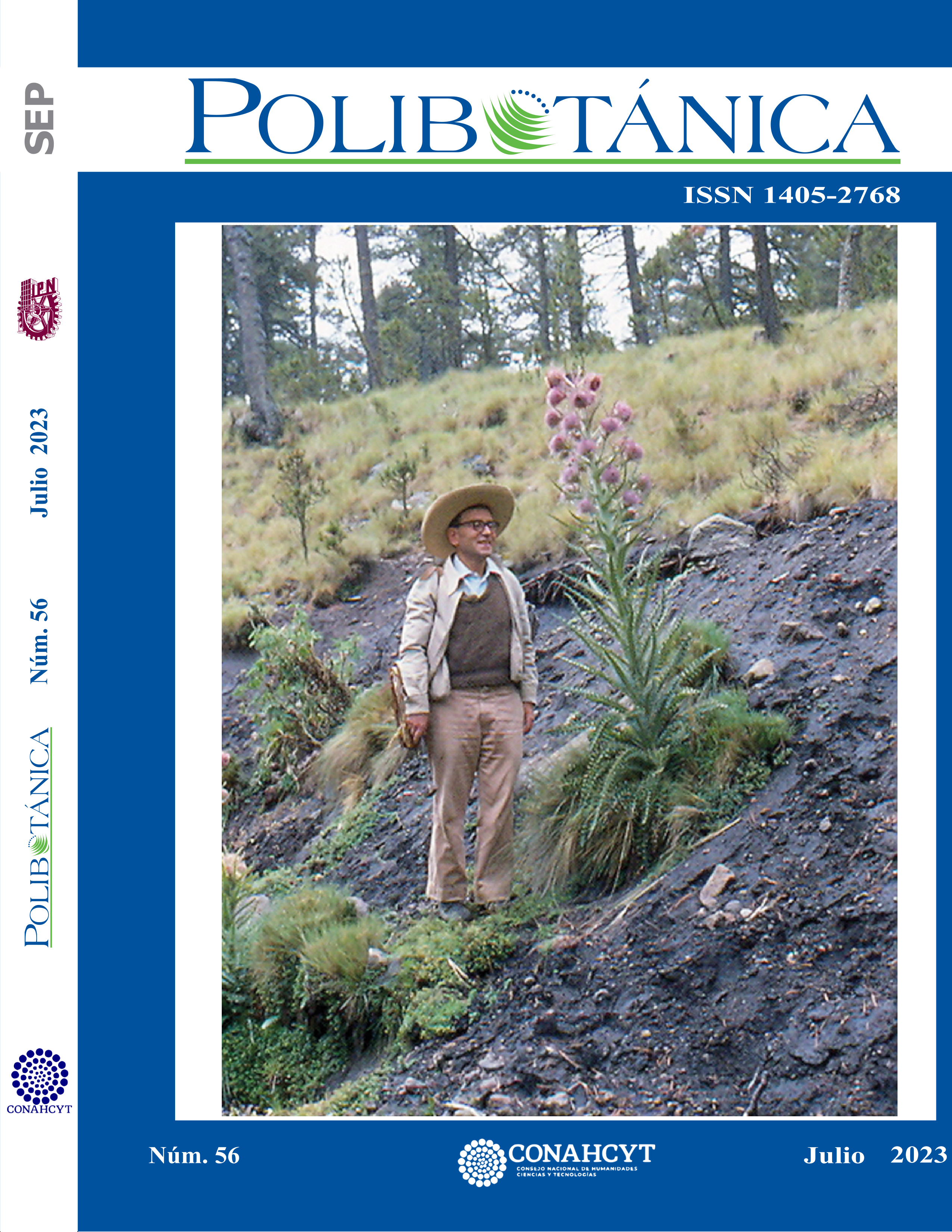Riqueza y distribución altitudinal de hepáticas epifitas del bosque de niebla de Hidalgo, México
DOI:
https://doi.org/10.18387/polibotanica.56.1Palabras clave:
Altitud, bosque templado, briofitas, Forofito, Marchantiophyta, Plagiochila, Riqueza de especiesResumen
Las hepáticas se distribuyen en forma heterogénea en su hábitat, pues dependen de condiciones micro ambientales particulares para su establecimiento. En este trabajo se presenta un listado florístico y se estima la semejanza en la composición de especies de hepáticas epifitas del bosque de niebla (BN) de Hidalgo, a lo largo de gradientes de altitud y latitud. Las muestras se tomaron en tres municipios con BN del estado de Hidalgo en un intervalo de altitud de 1345-2019 m. En cada sitio se colocaron dos parcelas de muestreo de 0.1 ha en los extremos del gradiente altitudinal. Dentro de cada parcela se seleccionaron 10 árboles y en cada uno de ellos se colocaron tres micro parcelas de 10×10 cm sobre su corteza para estimar la riqueza de especies. Se determinaron nueve familias, 17 géneros, 29 especies y dos variedades de hepáticas. Las familias Lejeuneaceae y Plagiochilaceae presentaron el mayor número de especies. Los géneros Lejeunea Lib y Plagiochila (Dumort.) Dumort. fueron los más diversos, con siete y cinco especies, respectivamente. La composición y riqueza de especies fue variable a lo largo de los gradientes analizados
Referencias
Alvarenga, L. D. P., & Lisboa, R. C. L. (2009). Contribuição para o conhecimento da taxonomia, ecologia e fitogeografia de briófitas da Amazônia Oriental. Acta Amazonica, 39(3), 495–504. https://doi.org/10.1590/s0044-59672009000300003
Ángeles, P. G. (2009). El bosque mesófilo de montaña en el estado de Hidalgo. In A. I. Monterroso Rivas (Ed.), El bosque mesófilo de montaña en el estado de Hidalgo: perspectiva ecológica frente al cambio climático (Primera, pp. 39–54). Universidad Autónoma Chapingo, Colegio de Posgraduados, Gobierno del Estado de Hidalgo.
Bernecker-Lücking, A. (1999). Key to Latin American species of Bazzania S . F . Gray. Tropical Bryology, 16, 117–126.
Cacua-Toledo, C. F., Serrano-Cardozo, V. H., & Ramírez-Pinilla, M. P. (2018). Composición y distribución de hepáticas (Marchantiophyta) en un intervalo altitudinal en la Cordillera Oriental de Colombia. Revista de Biología Tropical, 66(2), 559. https://doi.org/10.15517/rbt.v66i2.33379
Campos, L. V., Mota de Oliveira, S., Benavides, J. C., Uribe-M, J., & ter Steege, H. (2019). Vertical distribution and diversity of epiphytic bryophytes in the Colombian Amazon. Journal of Bryology, 41(4), 328–340. https://doi.org/10.1080/03736687.2019.1641898
Canché-Delgado, A., García-Jain, E. S., Vaca-Sánchez, M. S., & Cuevas-Reyes, P. (2011). Cambios en la morfología floral y foliar en Crataegus tracyi : importancia de la asimetría fluctuante como indicador de estrés ambiental. Biologicas, 13(1), 44–49.
Cavieres, L., & Piper, F. (2004). Determinantes ecofisiológicos del límite altitudinal de los árboles. In H. M. Cabrera (Ed.), Fisiología ecológica en plantas (pp. 221–234). Universidad de Concepción.
Christine, G. D., André, O., Jörg, B., & Robbert, G. (2013). Diversity and vertical distribution of epiphytic liverworts in lowland rain forest and lowland cloud forest of French Guiana. Journal of Bryology, 35(4), 243–254. https://doi.org/10.1179/1743282013Y.0000000070
Corrales, A., Duque, A., Uribe, J., & Londoño, V. (2010). Abundance and diversity patterns of terrestrial bryophyte species in secondary and planted montane forests in the northern portion of the Central Cordillera of Colombia. Bryologist, 113(1), 8–21. https://doi.org/10.1639/0007-2745-113.1.8
Crandall-Stotler, B., Stotler, R. E., & Long, D. G. (2009). Phylogeny and classification of the Marchantiophyta. Edinburgh Journal of Botany, 66(1), 155–198. https://doi.org/10.1017/S0960428609005393
Dauphin, G., Wunderlin, R. P., Essig, F. B., & Davison, P. G. (2011). A checklist of the liverworts (Marchantiophyta) and hornworts (Anthocerotophyta) of Florida. Journal of the Botanical Research Institute of Texas, 5(2), 773–814.
de Oliveira, S. M., & ter Steege, H. (2013). Floristic overview of the epiphytic bryophytes of terra firme forests across the Amazon basin. Acta Botanica Brasilica, 27(2), 347–363.
Delgadillo-Moya, C. (2022). Fifty years of bryology in Mexico. Botanical Sciences, 100(2), 263–273. https://doi.org/10.17129/botsci.2887
Delgadillo-Moya, C., & Juárez-Martínez, C. (2014). Biodiversidad de Anthocerotophyta y Marchantiophyta en México. Revista Mexicana de Biodiversidad, 85, 106–109. https://doi.org/10.7550/rmb.30954
Delgadillo, M. C. (1993). The Neotropical-African moss disjunction. Bryologist, 96(4), 604–615. https://doi.org/10.2307/3243992
Delgado, V., & Ederra, A. (2013). Long-term changes (1982-2010) in the bryodiversity of Spanish beech forests assessed by means of Ellenberg indicator values of temperature, nitrogen, light and pH. Biological Conservation, 157, 99–107. https://doi.org/10.1016/j.biocon.2012.06.022
Estepa-Ruiz, M. T., & Campos, L. V. (2022). Diversidad de hepáticas epífitas (Marchantiophyta) del sector Suasie en el Parque Nacional Natural Chingaza. Acta Biologica Colombiana, 27(1), 52–60. https://doi.org/10.15446/abc.v27n1.87497
Feuillet-Hutado, C., & Torres, A. M. (2016). Hepáticas epífitas : Riqueza en un gradiente altitudinal Andino , Departamento Del Cauca, Colombia. Boletín Científico, Museo de Historia Natural, 20(2), 33–42. https://doi.org/10.17151/bccm.2016.20.2.3
Frahm, J. P. (2003). Manual of tropical bryology. Tropical Bryology, 23, 1–196. http://tropical-bryology.org/Articles/open/VOL23/TB23.pdf%0Apapers3://publication/uuid/A295B8F2-742A-492E-86F4-B286B6CECB6A
Fulford, M. (1945). Studies on America Hepaticae-VI. Ceratolejeunea. Brittonia, 5(4), 368–403.
GBIF.org. (2022). Global Biodiversity Information Facility.
Glime, J. M. (2018). Tropics: Epiphyte Ecology. In Bryophyte Ecology. Volume 4. Habitat and Role. Michigan Technological University and the International Association of Bryologists.
Gradstein, R. (2016). The genus Plagiochila (Marchantiophyta) in Colombia. Revista de La Academia Colombiana de Ciencias Exactas, Físicas y Naturales, 40(154), 104–136. https://doi.org/http://dx.doi.org/10.18257/raccefyn.272
Gradstein, S. R. (1994). Lejeuneaceae: Ptychantheae, Brachiolejeuneae. Flora Neotropica, 62, 1–216.
Gradstein, S. R. (2015). Annotated key to the species of Plagiochila (Marchantiophyta) from Brazil. Pesquisas. Botânica, 67, 23–36.
Gradstein, S. R. (2017). Bazzania (Marchantiophyta) in South America. Nova Hedwigia, 105(1–2), 243–266. https://doi.org/10.1127/nova
Gradstein, S. R. (2020). The genera of Lejeuneaceae (Marchantiophyta) of tropical America-an update. Nova Hedwigia, 150, 81–96. https://doi.org/10.1127/nova-suppl/2020/081
Gradstein, S. R., Churchill, S. P., & Salazar-Allen, N. (2001). Guide to the Bryophytes of tropical America. Memoirs of The New York Botanical Garden, 86, 573.
Gradstein, S. R., & da Costa, D. P. (2003). The Hepaticae and Anthoceotae of Brazil (Vol. 87). Memoirs of The New York Botanical Garden.
Gradstein, S. R., & Hekking, W. H. . (1989). A catalogue of the Bryophytes of the Guianas I. Hepaticae and Anthocerotae. Journ. Hattori Bot. Lab., 66, 197–230.
Gradstein, S. R., & León-Yánez, S. (2020). Liverwort diversity in Polylepis pauta forests of Ecuador under different climatic conditions. Neotropical Biodiversity, 6(1), 138–146. https://doi.org/10.1080/23766808.2020.1809273
Granados-Sánchez, D., López-Ríos, G. F., Hernández-García, M. Á., & Sánchez-González, A. (2003). Ecología de las plantas epífitas. Revista Chapingo. Serie Ciencias Forestales y Del Ambiente, 9(2), 101–111.
Gual-Díaz, M., & Rendón-Correa, A. (2017). Los bosques mesófilos de montaña de México. Agroproductividad, 10(1), 3–9.
Gupta, R., & Asthana, A. K. (2016). Diversity and distribution of liverworts across habitats and altitudinal gradient at Pachmarhi Biosphere Reserve (India). Plant Science Today, 3(4), 354. https://doi.org/10.14719/pst.2016.3.4.263
Heinrichs, J., & Gradstein, S. R. (2000). A revision of Plagiochila sect. Crispatae and sect. Hypnoides (Hepaticae) in the Neotropics. I. Plagiochila disticha, P. montagnei and P. raddiana. Nova Hedwigia, 70(1–2), 161–184. https://doi.org/10.1127/nova.hedwigia/70/2000/161
Heinrichs, J., Renker, C., & Gradstein, S. R. (1999). A taxonomic revision of Plagiochila subplana Lindenb., a widespead of tropical America. Haussknechtia Beiheft, 9, 171–181.
Holz, I., & Gradstein, S. R. (2005). Cryptogamic epiphytes in primary and recovering upper montane oak forests of Costa Rica - Species richness, community composition and ecology. Plant Ecology, 178, 89–109. https://doi.org/10.1007/s11258-004-2496-5
Holz, I., Gradstein, S. R., Heinrichs, J., & Kappelle, M. (2002). Bryophyte diversity, microhabitat differentiation, and distribution of life forms in Costa Rican upper montane Quercus forest. The Bryologist, 105(3), 334–348. https://doi.org/http://dx.doi.org/10.1639/0007-2745(2002)105[0334:BDMDAD]2.0.CO;2
INEGI. (2022). Mapa de uso de suelo y vegetación. INEGI. Instituto Nacional de Geografía y Estadística. https://www.inegi.org.mx/temas/usosuelo/
Jardel Peláez, E., Cuevas Guzmán, R., Santiago Pérez, A. L., & Rodríguez Gómez, J. M. (2014). Ecología y manejo de los bosques mesófilos de montaña en México. Bosques Mesófilos de Montaña de México Diversidad , Ecología y Manejo, 141–187.
Johnson, A., & Kokila, P. (1970). The resistance to desiccation of ten species of tropical mosses. The Bryologist, 73(4), 682–686.
Köhler, L., Tobón, C., Frumau, K. F. A., & Bruijnzeel, L. A. (2007). Biomass and water storage dynamics of epiphytes in old-growth and secondary montane cloud forest stands in Costa Rica. Plant Ecology, 193, 171–184. https://doi.org/10.1007/s11258-006-9256-7
Ludwig, J. A., & Reynolds, J. F. (1988). Statistical Ecology: A Primer on Methods and Computing. Wiley-Interscience Publication.
Maidana, G. E. (2013). Aportes de la biogeografía histórica y la tectónica de placas. Contribuciones Científicas GÆA, 25, 137–148.
Marques, de O. J. R. do P., & Cavalcanti, P. K. (2007). Composição, riqueza e padrões de distribuição das hepáticas (Marchantiophyta) epífitas da Estação Ecológica Murici, AL, Brasil. Revista Brasileira de Biociências, 5(2), 1041–1043.
Mota De Oliveira, S., Ter Steege, H., Cornelissen, J. H. C., & Robbert Gradstein, S. (2009). Niche assembly of epiphytic bryophyte communities in the Guianas: A regional approach. Journal of Biogeography, 36(11), 2076–2084. https://doi.org/10.1111/j.1365-2699.2009.02144.x
Nekola, J. C., & White, P. S. (1999). The distance decay of similarity in biogeography and ecology. Journal of Biogeography, 26(4), 867–878. https://doi.org/10.1046/j.1365-2699.1999.00305.x
Norris, D. H., Kraichak, E., Risk, A. C., Lucas, D., Allard, D. J., Rosengren, F., Clark, T. A., Fenton, N., Tessler, M., Phephu, N., & Lennette, E. T. (2017). On the diversity and richness of understory bryophytes at Nectandra cloud forest reserve, Costa Rica. Biodiversity Data Journal, 5(1), 1–18. https://doi.org/10.3897/BDJ.5.e11778
Nöske, N. M., Hilt, N., Werner, F. A., Brehm, G., Fiedler, K., Sipman, H. J. M., & Gradstein, S. R. (2008). Disturbance effects on diversity of epiphytes and moths in a montane forest in Ecuador. Basic and Applied Ecology, 9, 4–12. https://doi.org/10.1016/j.baae.2007.06.014
Oliveira-da-Silva, F. R., & Ilkiu-Borges, A. L. (2018). Bryophytes (Bryophyta and Marchantiophyta) of the canga of the Serra dos Carajás, Pará, Brazil. Rodriguesia, 69(3), 1405–1416. https://doi.org/10.1590/2175-7860201869334
Reiner-Drehwald, M. E. (2000). Las Lejeuneaceae ( Hepaticae ) de Misiones , Argentina VI. Lejeunea y Taxilejeunea. Tropical Bryology, 19, 81–131.
Rodríguez-Quiel, E. E., Kluge, J., Mendieta-Leiva, G., & Bader, M. Y. (2022). Elevational patterns in tropical bryophyte diversity differ among substrates: A case study on Baru volcano, Panama. Journal of Vegetation Science, 33, 1–11. https://doi.org/10.1111/jvs.13136
Ruíz-Agudelo, C., & Aguirre-Ceballos, J. (2004). Las comunidades de briófitos y su relación con la vegetación fanerogámica (tipos de paisaje) en Tarapacá (Amazonas-Colombia). Caldasia, 26(1), 65–78.
Ruiz-Jiménez, C. A., Téllez-Valdés, O., & Luna-Vega, I. (2012). Clasificación de los bosques mesófilos de montaña de México: afinidades de la flora. Revista Mexicana de Biodiversidad, 83, 1110–1144. https://doi.org/10.7550/rmb.29383
Santos, N. D. Dos, Costa, D. P. Da, Kinoshita, L. S., & Shepherd, G. J. (2017). Variations in bryophyte communities in a short elevational gradient in Atlantic Forest of southeastern Brazil. Cryptogamie, Bryologie, 38(2), 191–211. https://doi.org/10.7872/cryb/v38.iss2.2017.191
Silva, J. B., Germano, S. R., Maciel-Silva, A. S., & dos Santos, N. D. (2019). A small elevational gradient shows negative bottom-to-top bryophyte richness in a seasonally dry forest in Brazil. Cryptogamie, Bryologie, 40(17), 219–231. https://doi.org/10.5252/cryptogamie-bryologie2019v40a17
So, M. L. (2005). Porella (Porellaceae, Marchantiophyta) in Latin America. New Zealand Journal of Botany, 43(1), 301–321. https://doi.org/10.1080/0028825X.2005.9512956
Soininen, J., McDonald, R., & Hillebrand, H. (2007). The distance decay of similarity in ecological communities. Ecography, 30, 3–12. https://doi.org/10.1111/j.2006.0906-7590.04817.x
StatSoft. (2008). Statsoft. Inc.
Tabua, M., Riley, R., Renner, M. A. M., Sӧderstrӧm, L., Hagborg, A., & Konrat, M. Von. (2017). Are epiphytic bryophyte communities characterized by changes along an elevational gradient?—A preliminary study on eastern Viti Levu, Fiji Islands. Bryophyte Diversity and Evolution, 39(1), 28–37. https://doi.org/10.11646/bde.39.1.6
Tropicos.org. (2022). Missouri Botanical Garden.
Valdez, T. V., Foroughbakhch, P. R., & Alanís, F. G. (2003). Distribución relictual del bosque mesófilo de montaña en el noreste de México. Ciencia UANL, 6(3), 360–365.
Valente, E. D. B., & Pôrto, K. C. (2006). Hepáticas (Marchantiophyta) de um fragmento de Mata Atlântica na Serra da Jibóia, Município de Santa Teresinha, BA, Brasil. Acta Botanica Brasilica, 20(2), 433–441.
Valente, E. de B., Pôrto, K. C., Bastos, C. J. P., & Ballejos-Loyola, J. (2013). Diversity and distribution of the bryophyte flora in montane forests in the Chapada Diamantina region of Brazil. Acta Botanica Brasilica, 27(3), 506–518. https://doi.org/10.1590/S0102-33062013000300008
Wolf, J. H. D. (1993). Diversity patterns and biomass of epiphytic bryophytes and lichens along an altitudinal gradient in the Northern Andes. Annals of the Missouri Botanical Garden, 80(4), 928–960.
Wolf, J. H. D. (1995). Non-vascular epiphyte diversity patterns in the canopy of an upper montane rain forest (2550-3670 m), Central Cordillera, Colombia. Selbyana, 16(2), 185–195.
Descargas
Publicado
Número
Sección
Licencia

Polibotánica por Departamento de Botánica de la Escuela Nacional de Ciencias Biológicas del Instituto Politécnico Nacional se distribuye bajo una Licencia Creative Commons Atribución-NoComercial-CompartirIgual 4.0 Internacional.




















